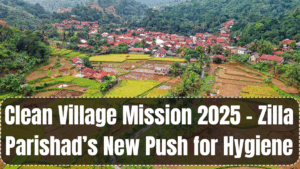The Clean Village Mission 2025 is gaining strong momentum across India’s rural landscape, as Zilla Parishads introduce new hygiene-focused initiatives to uplift sanitation standards at the village level. Building upon the success of earlier programs like Swachh Bharat Abhiyan, this mission aims to create zero-waste, open-defecation-free (ODF+) communities through sustainable, community-driven sanitation models.
In 2025, the focus has shifted from infrastructure to behavior change, maintenance, and smart waste management. The latest push under the Clean Village Mission emphasizes long-term cleanliness, decentralized waste handling, and public health education—all tailored to suit the needs of rural households.

Key Objectives of Clean Village Mission 2025
The Clean Village Mission launched by Zilla Parishads in 2025 revolves around five major objectives:
-
Sustainable Waste Disposal: Promoting compost pits, segregation at source, and community biogas plants
-
Toilet Access for All: Constructing and maintaining household and community toilets with water connections
-
Zero Open Defecation (ODF+) Compliance: Ensuring continued ODF status with solid and liquid waste management systems
-
Hygiene Awareness Drives: Weekly village campaigns focusing on handwashing, menstrual hygiene, and water safety
-
School and Anganwadi Cleanliness: Ensuring sanitation facilities are functional, clean, and child-friendly
This mission is closely aligned with the Jal Jeevan Mission and Ayushman Bharat for integrated sanitation and health outcomes.
New Initiatives Under the Mission
In 2025, several innovative programs have been launched under the Clean Village Mission, each with localized implementation:
-
Swachhta Samiti Formation: Every Panchayat now has a registered cleanliness committee responsible for waste audits, cleanliness checks, and awareness campaigns.
-
Swachh Gaon App: Villagers can now report cleanliness issues, track garbage collection schedules, and view their Panchayat’s cleanliness score in real time.
-
Plastic-Free Panchayat Drive: Villages are banning single-use plastic and setting up collection centers for recycling with support from local NGOs.
-
Solar-Powered Toilets: In water-scarce villages, solar-powered bio-toilets are being introduced to ensure sustainability.
-
School Hygiene Clubs: Students are being trained as ‘Swachhta Ambassadors’ to drive peer learning and household influence on hygiene practices.
Funding and Support
To implement the Clean Village Mission, Zilla Parishads are receiving dedicated funds under the 15th Finance Commission grants, SBM (Rural) Phase II, and CSR partnerships. In many districts, additional resources are pooled through MPLAD schemes and community donations.
Villages receive performance-based incentives for maintaining 100% sanitation coverage and reporting no littering or open defecation incidents for six months consecutively.
Technology and Transparency
Technology plays a key role in ensuring transparency in the mission’s rollout. Notable tools include:
-
Geo-tagged waste collection bins
-
Real-time dashboards accessible via Gram Panchayat portals
-
RFID tags on garbage collection vehicles
-
CCTV monitoring in communal toilets in pilot districts
These systems allow district officials and villagers alike to monitor progress and raise flags on delays or poor service delivery.
Community Participation and Impact
The most remarkable strength of the Clean Village Mission is its participatory approach. Villagers are trained in cleanliness habits, composting techniques, and public speaking to spread awareness. Cleanliness drives are now regular monthly events featuring songs, nukkad nataks (street plays), and rallies led by youth clubs.
Early impact reports from several districts show promising trends:
-
Over 68% of villages surveyed in Rajasthan and Maharashtra reported fully functional waste segregation units
-
Female participation in Swachhta Samitis increased by 40%
-
Diarrheal disease incidence in ODF+ villages has decreased by 20% within six months of sustained implementation
-
Over 8,000 solar toilets have been commissioned across tribal regions under the mission
FAQs
What is the Clean Village Mission 2025?
It is a sanitation initiative led by Zilla Parishads aiming to improve hygiene, waste management, and toilet access in rural villages through sustainable and community-driven efforts.
How does the mission ensure cleanliness in villages?
Through door-to-door waste collection, Swachhta Samitis, community toilets, and awareness campaigns supported by digital tracking and real-time dashboards.
Are these initiatives applicable to all villages?
Yes, the mission covers all Panchayats, with focus given to tribal, water-scarce, and backward regions first under a phased approach.
What are the incentives for clean villages?
Villages maintaining cleanliness, hygiene infrastructure, and community participation receive financial grants, award recognition, and additional development support.
Can villagers directly report sanitation issues?
Yes, using the Swachh Gaon App or through local Gram Sabha meetings and Panchayat reporting systems.
Click here to know more.
